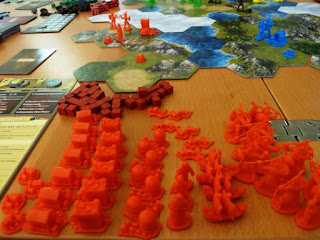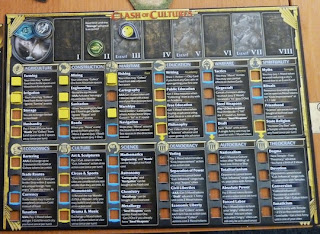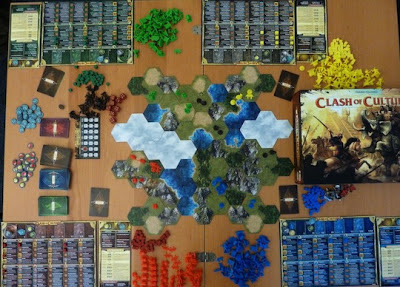This review is brought to you by the letter "C" - guest reviewer Chris C.
Clash of Cultures is a civilization building game for 2-4 players. It plays in about an hour per player. Designed by Christian Marcussen (also the creator of Merchants and Marauders), this game follows in a long tradition of historically-themed �4X� games, spanning back at least to the 1980 Avalon Hill classic, simply called Civilization. That board game was the inspiration for Sid Meier�s classic Civilization computer game, and this thread has bounced back and forth several times, resulting most recently in Fantasy Flight Games� popular 2010 release, Sid Meier�s Civilization: The Board Game. I'm happy to report that Clash of Cultures stands up very nicely against these giants.
Clash of Cultures is played over six rounds of three turns each. Each turn, players take three actions. Actions include moving units, researching technologies, harvesting resources and improving cities. As in most civilization games, players begin with one city and a settler unit and the board is configured with randomized face-down land tiles waiting to be explored. Each round is followed by a status phase where players have an opportunity to score objectives and then receive an action card, an objective card and a free technology advance. Action cards provide special abilities, while objective cards provide ways to score points. At the end of the game, players also receive points for each of their cities, their technology advances and constructed Wonders. The player with the most points wins.
Cities form the heart of each player�s civilization, and the game features a number of novel related mechanics. A city may be activated as an action to harvest resources, build units or increase its size with one of the four building types - temples, academies, ports and fortresses. As a city grows larger, it can harvest more resources and build more units. However, the size of individual cities is limited by the size of a player�s civilization, providing incentive to explore and found additional cities. If a city is activated twice in the same turn, its citizens become unhappy and will be less effective. Morale can be improved using mood tokens earned by researching new technologies.
The technology tree features a number of interesting options and combinations that I have not seen in previous 4X games. One example is the Trade Routes technology, which will earn players resources each turn for putting units in potentially vulnerable positions near enemy cities. Research technologies may also trigger events, where a player draws and resolves the top card from the event deck. These can be good or bad - the player might be attacked by barbarians or simply have a good harvest. Events introduce a substantial element of luck to the game, but also add much-needed variety and replayability.
The novel mechanics are supported by the excellent components. Cities are round plastic miniatures, and the buildings are on curved bases so that each fits beautifully around the city taking up a quarter of the circle. Each player receives plastic warriors, settlers and ships in their color and as they march across the landscape the game takes on an epic feel quickly. The individual player boards list the entire tech tree. They are made of thick cardboard with square holes next to each technology - when a player researches a new tech, they simply place a cube in the appropriate hole. This basic idea is a major improvement on previous 4X games, where players must often search through a deck of technology cards and refer to the manual if they wish to see all of the dependencies. Each player also gets a reference card clearly listing the game�s phases, the ways to earn points, and the cost of each unit and building.
Though this game is excellent, it is not without flaws. I wish more had been done to encourage combat earlier in the game. In the groups I have played with, it is quite rare for players to attack each other before the last round of the game (and then only to attempt to capture cities containing valuable Wonders). It is relatively inexpensive to found new cities, and additional cities after the first few do not benefit a player during the game, so there is little reason to attack other players earlier. As a result, the game doesn�t have as much direct interaction as one might expect from a Civilization game. This problem was solved elegantly, for example, in Empires of the Void, where mid-game scoring rounds provide an incentive to take planets from other players earlier.
The game does try to encourage combat with the objective card deck. Each card lists two ways for the player to score points, one having to do with building up a civilization, and the other having to do with warfare. However, players may only complete one of the two possibilities and both are worth the same number of points. Since the civilization-building objectives are easier and combat will usually weaken the two players involved to the advantage of the other players, the groups I have played with have rarely attempted the combat objectives. Additionally, the civilization-building objectives aren�t as varied as I�d like. More than half fall into a few basic categories like building up a certain number of resources or completing a certain branch of the tech tree. And, unlike in Sid Meier�s Civilization: The Board Game, players do not have races with unique powers, so the game doesn�t feel as varied over repeat plays as I�d like.
These complaints are fairly minor, considering the overall quality of the game. Any fan of Civilization-style games should pick this one up immediately. It�s also a great choice for gamers new to the genre - it has an excellent rule book and is easier to learn and play than the Sid Meier�s Civilization board game, even if it lacks a little of that game�s variety. It also works very well with 2 or 3 players, which is a bit rare for this style of game. And while it might seem like a small thing, the game�s innovative components relating to cities and tech trees really make it a joy to play.
If Clash of Cultures sounds interesting, you should also check out Empires of the Void, Civilization (by Fantasy Flight Games), and Civilization (by Eagle Games).
I would like to thank Z-Man Games for providing Board Game Reviews by Josh with a review copy of Clash of Cultures.
Clash of Cultures is a civilization building game for 2-4 players. It plays in about an hour per player. Designed by Christian Marcussen (also the creator of Merchants and Marauders), this game follows in a long tradition of historically-themed �4X� games, spanning back at least to the 1980 Avalon Hill classic, simply called Civilization. That board game was the inspiration for Sid Meier�s classic Civilization computer game, and this thread has bounced back and forth several times, resulting most recently in Fantasy Flight Games� popular 2010 release, Sid Meier�s Civilization: The Board Game. I'm happy to report that Clash of Cultures stands up very nicely against these giants.
Clash of Cultures is played over six rounds of three turns each. Each turn, players take three actions. Actions include moving units, researching technologies, harvesting resources and improving cities. As in most civilization games, players begin with one city and a settler unit and the board is configured with randomized face-down land tiles waiting to be explored. Each round is followed by a status phase where players have an opportunity to score objectives and then receive an action card, an objective card and a free technology advance. Action cards provide special abilities, while objective cards provide ways to score points. At the end of the game, players also receive points for each of their cities, their technology advances and constructed Wonders. The player with the most points wins.
 |
| Beautifully sculpted pieces. |
The technology tree features a number of interesting options and combinations that I have not seen in previous 4X games. One example is the Trade Routes technology, which will earn players resources each turn for putting units in potentially vulnerable positions near enemy cities. Research technologies may also trigger events, where a player draws and resolves the top card from the event deck. These can be good or bad - the player might be attacked by barbarians or simply have a good harvest. Events introduce a substantial element of luck to the game, but also add much-needed variety and replayability.
The novel mechanics are supported by the excellent components. Cities are round plastic miniatures, and the buildings are on curved bases so that each fits beautifully around the city taking up a quarter of the circle. Each player receives plastic warriors, settlers and ships in their color and as they march across the landscape the game takes on an epic feel quickly. The individual player boards list the entire tech tree. They are made of thick cardboard with square holes next to each technology - when a player researches a new tech, they simply place a cube in the appropriate hole. This basic idea is a major improvement on previous 4X games, where players must often search through a deck of technology cards and refer to the manual if they wish to see all of the dependencies. Each player also gets a reference card clearly listing the game�s phases, the ways to earn points, and the cost of each unit and building.
 |
| The highly intuitive player board |
The game does try to encourage combat with the objective card deck. Each card lists two ways for the player to score points, one having to do with building up a civilization, and the other having to do with warfare. However, players may only complete one of the two possibilities and both are worth the same number of points. Since the civilization-building objectives are easier and combat will usually weaken the two players involved to the advantage of the other players, the groups I have played with have rarely attempted the combat objectives. Additionally, the civilization-building objectives aren�t as varied as I�d like. More than half fall into a few basic categories like building up a certain number of resources or completing a certain branch of the tech tree. And, unlike in Sid Meier�s Civilization: The Board Game, players do not have races with unique powers, so the game doesn�t feel as varied over repeat plays as I�d like.
These complaints are fairly minor, considering the overall quality of the game. Any fan of Civilization-style games should pick this one up immediately. It�s also a great choice for gamers new to the genre - it has an excellent rule book and is easier to learn and play than the Sid Meier�s Civilization board game, even if it lacks a little of that game�s variety. It also works very well with 2 or 3 players, which is a bit rare for this style of game. And while it might seem like a small thing, the game�s innovative components relating to cities and tech trees really make it a joy to play.
If Clash of Cultures sounds interesting, you should also check out Empires of the Void, Civilization (by Fantasy Flight Games), and Civilization (by Eagle Games).
I would like to thank Z-Man Games for providing Board Game Reviews by Josh with a review copy of Clash of Cultures.



0 komentar:
Posting Komentar